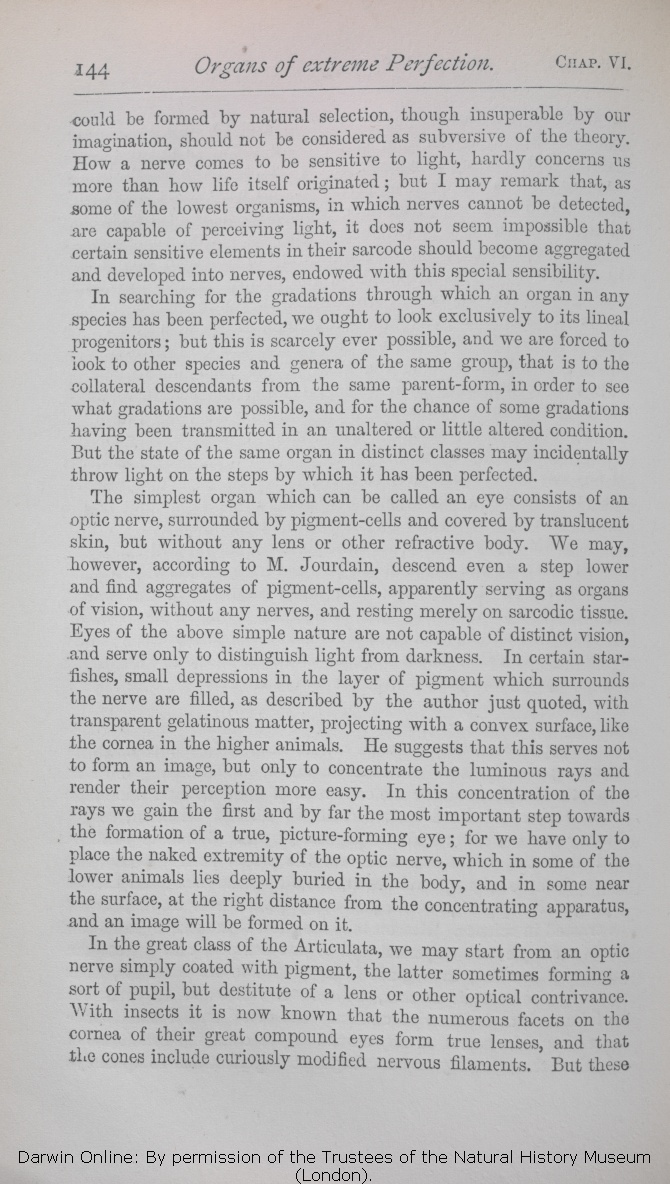perfect and complex eye could
be | be 1859 1860 1861 1869 1872 | | have been 1866 |
| should not 1872 | | can hardly 1859 1860 1861 1866 | | cannot 1869 |
| as subversive of the theory. 1872 |
| real. 1859 1860 1861 1866 1869 |
| ..... 1872 | | first 1859 1860 1861 1866 1869 |
| that, 1866 1869 1872 | | that 1859 1860 1861 |
| as some of the lowest organisms, in which nerves cannot be detected, are capable of perceiving light, it does not seem impossible that certain sensitive elements in their sarcode should become aggregated and developed into nerves, endowed with this special sensibility. 1872 |
| several facts make me suspect that any sensitive nerve may be rendered sensitive to light, and likewise to those coarser vibrations of the air which produce sound. 1859 1860 |
| several facts make me suspect that nerves sensitive to touch may be rendered sensitive to light, and likewise to those coarser vibrations of the air which produce sound. 1861 |
| as some of the lowest organisms, in which nerves cannot be detected, are known to be sensitive to light, it does not seem impossible that certain elements in their tissues or sarcode should have become aggregated and developed into nerves endowed with special sensibility to its action. 1866 |
| as some of the lowest organisms, in which nerves cannot be detected, are known to be sensitive to light, it does not seem impossible that certain elements in the sarcode, of which they are mainly composed, should become aggregated and developed into nerves endowed with this special sensibility. 1869 |
|
|
In
searching | searching 1866 1869 1872 | | looking 1859 1860 1861 |
| through 1866 1869 1872 | | by 1859 1860 1861 |
| an 1859 1860 1861 1869 1872 | | any 1866 |
| progenitors; 1866 1869 1872 | | ancestors; 1859 1860 1861 |
| OMIT 1869 1872 |
| in each case 1859 1860 1861 1866 |
| other species and genera 1866 1869 1872 |
| species 1859 1860 1861 |
| ..... 1869 1872 | | original 1859 1860 1861 1866 |
| OMIT 1869 1872 |
| from the earlier stages of descent, 1859 1860 1861 1866 |
| condition. 1859 1860 1866 1869 1872 | | condi- tion. 1861 |
| same organ 1872 | | organ even 1869 |
| perfected. 1872 | | perfected 1869 |
| 1 blocks not present in 1869 1872; present in 1859 1860 1861 1866 | | Amongst existing Vertebrata, we find but a small amount of gradation
in the structure
of the eye, and from fossil species we can learn nothing on this head. |
|
|
The simplest organ which can be called an eye consists of an optic nerve, surrounded by
pigment-cells | pigment-cells 1869 1872 | | pigment-cells, 1866 |
| and covered 1872 | | covered 1866 1869 |
| organs 1872 | | organ 1866 1869 |
| without any nerves, and resting 1872 |
| but which rest 1866 |
| but without any nerve, and resting 1869 |
| tissue. 1869 1872 | | tissue 1866 |
| ..... 1869 1872 | | furnished 1866 |
| ..... 1869 1872 | | nerve. 1866 |
| only 1869 1872 | | merely 1866 |
| surrounds 1866 1872 | | sur- rounds 1869 |
| projecting 1869 1872 |
| and this projects outwardly 1866 |
| ..... 1869 1872 | | structure 1866 |
| easy. 1869 1872 | | perfect. 1866 |
|
In the great class of the Articulata,
..
we
...| OMIT 1869 1872 |
| look for gradations, we 1866 |
| the latter sometimes forming 1869 1872 |
| which sometimes forms 1866 |
| facets on the cornea of their 1872 |
| cones surrounded by pigment, which form the 1866 |
| facets on the cornea of the 1869 |
| form true lenses, and that the cones include curiously modified nervous filaments. 1869 1872 |
| are filled with transparent refractive matter, and these cones produce images; but in addition, in certain beetles the facets of the cornea are slightly convex both externally and internally,—that is, are lens-shaped. 1866 |
| But these organs in the Articulata are so much diversified 1872 |
| Altogether so diversified is the structure of the compound eyes, 1861 |
|









